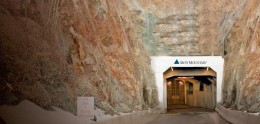In 2014 Our Government Is Still Filing Retirement Paperwork by Hand

In Boyers, Pa. there are 600 people who work in a limestone mine, but they’re not digging up natural resources or anything like that — they work for the Office of Personnel Management, and their job is to process the retirement paperwork of U.S. government workers. They work in a mine because they need the space, and they need the space because they need room for 28,000 file cabinets. Though it’s 2014, the majority of the paperwork is still processed and filed by hand. David A. Fahrenthold explains how this came to be in his appropriately titled story for The Washington Post, “Sinkhole of Bureaucracy.”
It’s not that the government hasn’t tried to digitize — it has — it’s that it has tried to digitize in various years and administrations and has failed to get a system to work:
During the past 30 years, administrations have spent more than $100 million trying to automate the old-fashioned process in the mine and make it run at the speed of computers.
They couldn’t.
So now the mine continues to run at the speed of human fingers and feet. That failure imposes costs on federal retirees, who have to wait months for their full benefit checks. And it has imposed costs on the taxpayer: The Obama administration has now made the mine run faster, but mainly by paying for more fingers and feet.
The staff working in the mine has increased by at least 200 people in the past five years. And the cost of processing each claim has increased from $82 to $108, as total spending on the retirement system reached $55.8 million.
Employees are aware of how ridiculous this all is and tells Fahrenthold that the slow process has led many of them to quit:
“I used to chase people for months — literally — for one signature on one piece of paper. You want to talk about an egregious waste of taxpayer money?” recalled one worker who left the mine recently and declined to be named because of fears of retribution.
This step usually takes a few days to a few weeks. But if anybody’s file is misplaced along the way, it slows everybody’s work down.
“On a daily basis, we would get from five to 50 e-mails, asking everybody to take time out of their day to search their desks for case files,” the former worker said. That worker said the experience of hunting down lost paperwork and lost files inside an underground cavern had been bad enough to force a career change.
Our government has had a history of problems with information technology, the most recent example being the rollout of the government health care exchange websites. Perhaps it should start putting emphasis on recruiting all those talented developers who are heading to Silicon Valley to make apps. Surely we are past the point of having 600 people running around in an underground mine filing paperwork in manila folders stuffed in file cabinets.
Support The Billfold
The Billfold continues to exist thanks to support from our readers. Help us continue to do our work by making a monthly pledge on Patreon or a one-time-only contribution through PayPal.
Comments